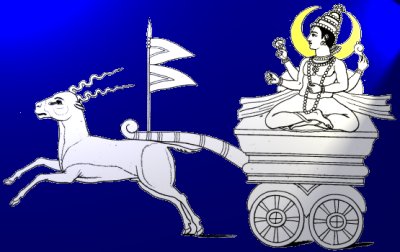



Image from Moor.
Basic Description: Soma is the god of the moon. He is seated on the pedestal of lotus placed in a beautiful chariot pulled by seven horses. He is one of the Nine Planets.
Alternate Names: Kumudapati (Lord of lotus), Mriganga (Spotted), Pavamana (Liqueur purifier), Oshadipati (King of grass), Shivashekara (Crest of Shiva), Sitamarici (With cool rays), Somanatha or Someshwara (Lord of the Soma), Chandra.
History/Practices: Chandra and Soma merged in later Hinduism. The most effective way to get Soma to answer one’s prayers is to worship him on Monday. Since the Hindu name for the day Monday, Somavara, is named after him. Palasa is sacred to him.
The devouring process is often viewed as the only lasting component of the universe. Thus, the devourer and the devoured are crucial components of existence. Soma is the offering, the fuel for this process to occur. It is also the cold, the moon, the food, the victim, the sperm, and the wine.
Every offering thrown into the ritual fire is soma. Importantly, Soma is considered the beverage of immortality (amrta), first produced by the churning of the ocean. The 114 hymns of the 9th book of the Rig Veda are in praise of the deified Soma. Soma is the healer, the lord-of-all, and sometimes identified with the Supreme Being.
Soma’s meaning originated from its use as an intoxicating drink from a climbing plant, offered to gods, ingested by Brahman priests, and considered the wine of immortality. The stalks of the soma plant (amshu) are smashed between stones and the juice is mixed with beer or milk and then offered to the gods. This is a symbol of replacement of common pleasure with divine bliss.
Iconography: He has many different forms. He is seen as a celestial bull, a bird, a giant rising from the waters, the lord of plants, and as an embryo. He rarely is seen as a fully grown human, though sometimes represented as a priestly sage. Soma is often dark in color, like the night, or copper colored. Most often shown seated on a lotus in a chariot being drawn either by two antelope or seven white horses. He has a red banner and rides in a chariot drawn by an antelope.
Mythology: There are many strands to Soma. First, he is the life giving ritual beverage used in sacrifice. He is the life blood of animals and the sap of plants. Soma is often associated with the moon in early mythology. In fact, the Soma is the most common name for the moon in the Mahabharata. The moon is the symbol of the world beyond death, once again establishing the symbolism of immortality. The moon is also seen as a watery element that controls the oceans and brings rain to the earth. Kept in a bronze castle, Soma was brought to earth by a large hawk or by a thunder bolt (Indra). Soma is considered in one myth, the son of Atri and Anasuya. Soma is the third son of Atri in Atri’s first incarnation. Soma was a drink consumed by the gods for power to rise above all obstacles. Inrda is considered the greatest drinker of soma, with Agni following close behind in consumption. Warriors, holy men, lovers and poets alike drink soma for inspiration.
Myth concerning Rohini: the other Nakshatras were upset at Chandra’s obvious preference for Rohini so they told their father Daksha. Daksha argued with Chandra and when Chandra refused to repent, cursed him with consumption. Now ailing, Chandra finally repented and after fifteen days Daksha cured him.
Myth concerning Tara: Chandra adored Tara so much that he kidnapped her. For a while he refused to return her, but eventually Brahma convinced him to give her back. When she was returned to Brahmanaspati she was discovered to be pregnant. When the child was born, she named him as Chandra’s child. Brahmanaspati was angered by this and incinerated her, but she was revived by Brahma and once again reunited with Brahmanaspati. After this Brahma forbade Chandra from entering the heavens, thus he has been forced to remain in the sky.
Riding Animal: His vahana (vehicle) is an antelope.
Consort: Candi